
Categories
The Importance of Prehabilitation
We are all familiar with the term rehabilitation, which refers to the process of recovering from injury. It’s something that we do reactively, and depending on the severity of the injury or condition, can take weeks or months, which is why in sports conditioning and athletic training circles, there is huge emphasis in preventing injury – it doesn’t matter how fit and strong you are if you are permanently injured, right?<
And that’s where ‘prehabilitation’ comes into play – the proactive practice and training to specifically prevent injuries. Yes the approach will be different for everyone, depending on your starting point and pursuits, but there are five areas of ‘prehab’ that we should all focus to keep ourselves injury-free and on the right fitness track.
1. Soft tissue work:
Soft tissue work refers to therapy work on the muscle, connective tissue and fascia – the sheath of connective tissue fibre which covers the whole body.
When we exercise, all of the above become stressed and over time can become overused, tight and develop adhesions which cause our joints to become restricted, which means we’re more injury prone. Soft tissue therapy, in the form of massage, active release technique, manual treatment, or via a foam roller and hockey ball, acts to relieve tension, work out any niggles and help to keep our joints healthy.
2. Focussed stretching:
A lot of conflicting advice on stretching has been written recently – what should we do and when, and should we do it at all?
The truth is that most of us would benefit from doing some, whatever it is, and whenever we can fit it in. The caveat is that that we should only stretch what needs stretching, otherwise we can increase the risk of injury, so remember to take a focused and specific approach. I like the idea of 15 minutes each week for every decade of your age – which would be three weekly 15 minutes blocks for those of us in our thirties.
3. Postural balance exercises:
The benefits of good posture is widely researched.
However, while we should all look to balance the muscles in the hips and shoulder regions so that we function in balance, remember that we are all different and express good posture in our own way. Many of us are however are relatively tight in the chest and weak in the muscles of the upper back for example, something that we can address by performing lots of rowing and pulling exercises.
4. Adequate rest:
Most injuries, especially those which aren’t trauma related, occur because of fatigue.
This could be due to muscular fatigue, where we do not rest enough between sessions, or psychological fatigue where we are mentally fatigued, brought about through other stressors, such as lack of sleep, inadequate nutrition. The amount of rest and recovery we require will be different, depending on our own personal circumstances, but if we want to stay injury free, we need to make sure that we put back what we take out.
5. Sound nutrition:
It’s hard to read an article on fitness without being told about the importance of nutrition and hydration, and for good reason.
Regardless of other strategies you have put into place, how you fuel your body is vitally important if you want to make progress. Prolonged poor nutrition can lead to physical and mental fatigue, which then leads to injury. More acute conditions, including impaired concentration, cramp and hypoglycaemia (low blood sugar), are also common when people do not get the nutrients that they need.
If you have any questions on the above or would like some advice on how we could help you with your fitness goal, don’t hesitate, visit our gym in City of London and try one of our personal training sessions.
Related Articles
- How to Prevent Common Gym Injuries
- The Importance of Movement Prep
- Stretching Good or Bad?
- Is Stretching Really That Effective After a Workout?
- What Does a Foundry Warm Up Include?

